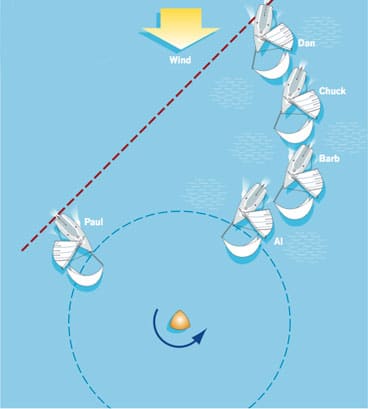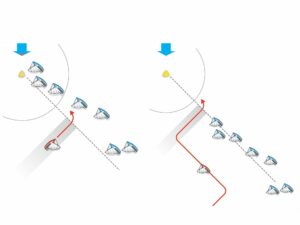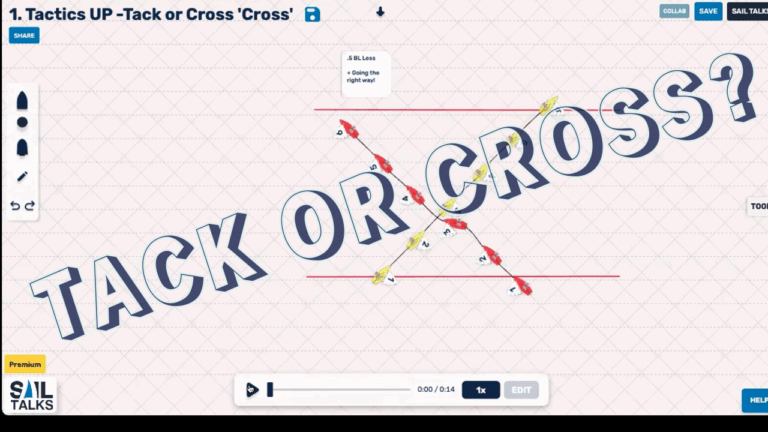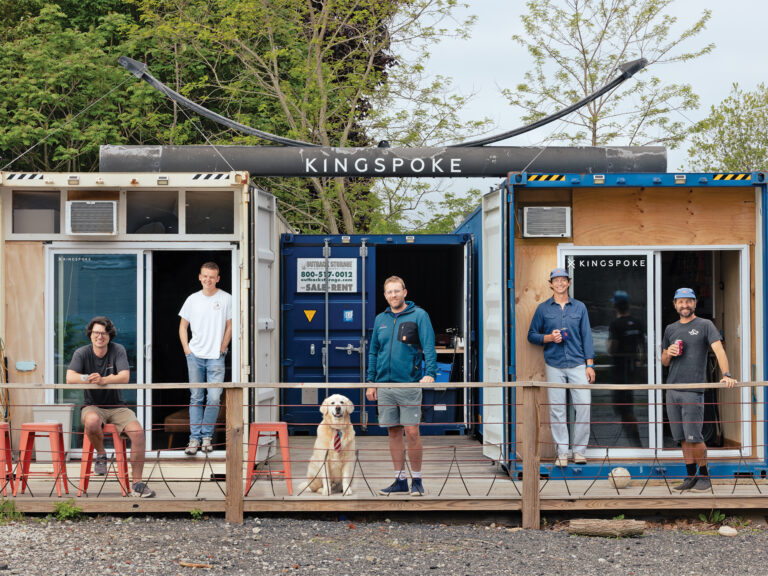
overlapping mark room
Numerous recent questions from readers indicate they’re having difficulty figuring out how new Rule 18 and the revised definition of overlap work at leeward marks.
The word “overlap” is used in the racing rules with a special technical meaning that you can find in the Definitions section at the back of the rulebook. As we will see, that definition differs markedly from the meaning we give to the word, “overlap,” in casual everyday speech. The rulebook’s definition of overlap depends on knowledge of two other defined terms, clear astern and clear ahead.
Let’s apply the overlap definition and the rules to the situation shown in the first diagram. A fleet of Melges 24s is planing toward the leeward mark on a gusty day. Paul is about to enter the zone around the mark on port tack. Under Rule 18.2(b) he must give mark-room to all boats overlapped with him at the moment his hull reaches the zone. From the last sentence of the definition, you can see that the terms clear astern, clear ahead, and overlap applied between Paul and each of the other four boats shown in the diagram as they approached the zone because Paul and each of them were on opposite tacks and all of them were sailing more than 90 degrees from the true wind.
Paul and Al were about even. Barb was a couple of lengths behind, and Chuck and Dan were well behind. Nevertheless, if you draw a line across Paul’s stern at 90 degrees to the centerline of his boat, you will see that Barb, Chuck, and even Dan are overlapped with Paul. This is the case because Barb and Chuck are entirely ahead of that line, and part of Dan’s hull is ahead of it.
Now, suppose Paul is in an area of light wind and that the four starboard-tack boats are roaring down toward the mark in a sharp gust. From the moment Paul’s hull reaches the zone, Rule 18.2(b) applies between Paul and each of those four boats. In addition, Rule 10 applies, even inside the zone. Therefore, poor Paul is in a pickle—he must give each starboard boat mark-room under Rule 18.2(b) and also keep clear of each of them under Rule 10.
If the mark is not a gate mark, Rule 18.4 puts some restriction on the course that the starboard boats are permitted to sail—they may sail no further from the mark than their proper course would take them, and, when they reach the point where their proper course is to jibe to round the mark, they must do so.

In the second diagram, we see a fleet of Lasers running directly downwind toward a leeward mark. All five boats are on the same tack. We will examine the perils of Pauline. If you draw a line across the aftermost part of her boat at right angles to her centerline, you’ll see that Tom’s bow is ahead of the line, but Dick, Harry, and Lou are all well behind it. If Tom were not in the picture, then Dick, Harry, and Lou would be clear astern of Pauline and she would be under no obligation to give any of them mark-room. However, Tom is present and between Pauline and Dick. Applying the fourth sentence of the definition, at the very moment shown in the diagram, when Pauline’s hull reaches the zone, she is overlapped with Dick because Tom is in the space between her and Dick, and Tom overlaps both of them. Applying the same sentence again, you see that Tom is overlapped with Harry because Dick overlaps both Tom and Harry, and he is between them. Finally, applying that same sentence a third time, you see that Pauline is overlapped with Harry because Dick is a “boat between them” and overlaps them both.
What about Lou? Tom overlaps both Pauline and Lou. However, Pauline and Lou are not overlapped because Tom is not between them. Indeed, the only thing between Pauline and Lou is open water.
Beginning from the moment Pauline’s hull reaches the zone, she must give mark-room to Tom, Dick, and Harry under Rule 18.2(b). However, under Rule 11, Pauline retains right of way over each of those three competitors, and therefore needs only to give them “room to sail to the mark” and not the space each of them might like to sail their proper course . Under Rule 18.2(b) Lou, who is clear astern of Pauline, must give her mark-room, and under Rule 12 he must also keep clear of her.
| Kim Downing |
| ** ** |
Now let’s consider the third diagram. Two boats, Gambler and Steadfast, are in a battle to determine whether or not they will be overlapped when Gambler‘s bow reaches the zone. At position 1 Steadfast has just become overlapped inside Gambler, and she hails “Mark-room!”
Gambler replies, “No way, we’re not at the zone yet.” Then, just before she reaches the zone, Gambler luffs, which breaks the overlap, and as her bow enters the zone, she hails, “I’m in the zone now. No overlap.” To which Steadfast coolly replies, “Protest.” The boats round the mark with Steadfast giving Gambler mark-room and keeping clear of her.
After returning to shore, Steadfast protests Gambler asserting the boats were more than three hull lengths away from the mark while Gambler was making her luff and bear away and that later, when Gambler‘s bow entered the zone, they were overlapped. If I had to bet which boat would win this protest, I’d put my money on Steadfast. Even though Gambler‘s analysis is technically correct under the rules, I think her chances of winning the protest are slim for two reasons. (1) It’s impossible to know precisely when your bow enters the zone. Gambler may think she timed her luff with precision, but Steadfast and witnesses may not agree. If Gambler cannot convince the protest committee to find as fact that her timing was perfect, then it may well find that she reached the zone after her quick luff-and-bear-away move and that, at that deciding moment, the boats were overlapped. (2) Alternatively, after hearing the testimony, the committee may doubt whether there was an overlap at the critical moment. If this happens, then Rule 18.2(d) will apply, which states “If there is reasonable doubt that a boat . . . broke an overlap in time, it shall be presumed that she did not.”
Since, by her hails and actions, Gambler showed that she believed Steadfast had an overlap just before the zone, Rule 18.2(d) would lead the committee to rule that Gambler improperly denied Steadfast mark-room and disqualify Gambler for breaking Rule 18.2(b) by not giving Steadfast mark-room.
E-mail for Dick Rose may be sent to rules@sailingworld.com









